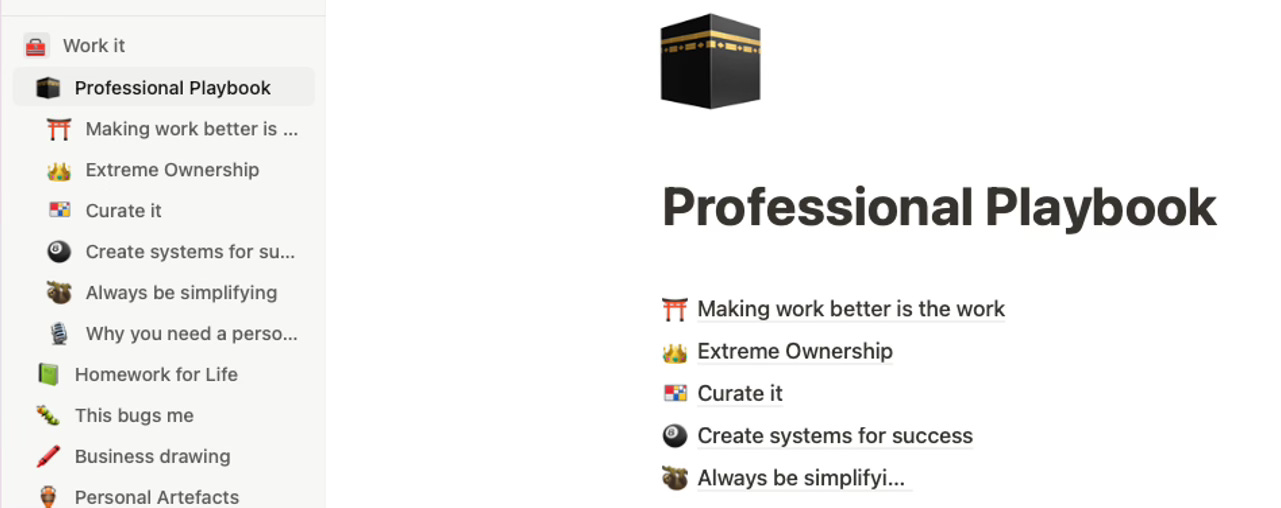How to become a killer Product Manager in 3 easy steps
It may be a top contender for the most clickbait headline ever used by a product person, but my promise to you today is that you can become a killer PM, in 3 easy steps, by following a simple practice and using digital tools that you either already have or can get for free.
Sound too good to be true? Let’s take a look at step number one.
1. Steal some principles
Well, surely you weren’t expecting it to be ethical as well?
It’s ok, I’m just messing with you - this is 100% above board! So to clarify, in this context I don’t mean to plagiarize or rip off other people’s work.
I mean steal like steal like an artist - which is to give yourself permission, not to have to come up with ground-breaking ideas from scratch, but to get inspired by what other people have done.
If you just put 2+2 together and are now wondering who I stole this idea from…
My inspiration initially came from a series of articles published by Naomi Gleit. She is The Head of Product at a small company you may have heard of, called Meta. And because I am young and impressionable, I immediately wanted to be her when I grow up.
According to Nomes:
“I wrote down all of my best practices, frameworks and processes about how to be a killer PM and shared them with my colleagues at Meta…”
And now, I am going to share these hot tips with you…
Naomi-isms
Nomes breaks each one down into a separate post - but collectively they become a playbook:
1. (Naomi-isms) she calls these principles Naomi-isms, because when you are the Head of Product at Meta… fair play.
2. Understand, Identify, Execute. The principles behind discovery and delivery condensed into a page. Mind blown!
3. Extreme Clarity is about everyone being on the same page.
4. Canonical Everything write down your governance, and structure your key information.
5. PM as Conductor – a great metaphor for the role of a PM.
6. Simplifiers – the art of being able to explain complex situations.
7. People and Process - having a single threaded owner.
8. Building a Bench - the importance of doing yourself out of a job.
You will see later how much these inspired me, but here are some examples of other collections of principles worth stealing looking at.
David Cole’s Personal Canon
David Cole was VP of Design at Quora, amongst other things. That’s why his page has extra white space and a grid layout. But we all love our designers right? Remember without them, everything would look like excel.
What he has very nicely done is group his collected inspiration into the topics of Purpose, Process, Product, User Experience and Craft.
Timeless Concepts by Jim Collins
You may have heard of or read the book “Good to Great” by Jim Collins.
His books have sold 10 million copies worldwide – WHY? Because they contain a really great set of principles that he calls timeless concepts. These he groups into the categories of Disciplined People, Disciplined Thought, Disciplined Action and Building to Last.
Leadership Lessons from Ted Lasso
So this dude was of course one of the keynote speakers at the Atlassian conference last month. Examples of his principles are at the other end of the spectrum, and are not so much about shaping the work, but surviving it.
As product managers, we all navigate complex work environments and deal with uncertainty in our professional lives on a regular basis. That complexity is not going to go away any time soon. Unfortunately the thing about working in product is, there’s always some kind of monster chewing on your leg.
Molly Graham is the brilliant author of this article. She’s talking about startups, but it applies to almost any area of product. To quote Molly directly:
“You’re fighting to survive and for people to give a shit about your company […or product]. There’s no way that the stress of building something from scratch doesn’t affect your emotions. You’re cycling through anxiety, fear, euphoria, boredom and then back to fear again as the situation changes, and that’s completely normal…”
… all the emotions that come with navigating a fast-growing company are like a monster chewing on your leg.
"If you deal with your emotions properly while scaling, you can work towards cultivating a mindset that allows you to thrive. Even in the thorniest of startup situations, I've found there's a way to focus on the positive and on what you can learn,"
Just like Ted Lasso.
Why is it so important to be thriving not just surviving as PMs? Lenny Rachitsky has another metaphor for the role of the Product Manager, calling the PM the beating heart of a product team.
You see - the secret sauce of being a product manager - is that is enabling others to do their best work, is ultimately what creates the best product outcomes.
To create the dream you must build the team.
And to build anything you have to have the right tools, but for such a big job like this, you don’t just need a bigger toolkit, you’re going to need to…
2. Build another brain
But don’t worry no brain surgery skills required and you don’t need to be a brilliant designer, have sold a million books, or head up product at Meta, to create your own personal playbook.
Anyone can bodge one together, because step 2 is about how to create your new toolkit by setting up a digital system to save and synthesise your ideas.
Building a second brain
The concepts behind (and book of the same name) Building a Second Brain by Tiago Forte are the essential guide to that process of organising your digital life, curating information, capturing notes and becoming more productive.
But I’m going to jump straight into the examples of how I created a playbook using Tiago’s techniques.
Playbook Toolkit
For my own personal set-up I use both Raindrop.io and Notion. But honestly you can start with the bookmarks or favorites of any web browser. The key is - it must have some kind of editable structure through either folders or tags. (NB: see the saved links in Raindrop above to the examples of other playbooks I shared before?)
I took all the articles I found in step one and initially saved them into one folder called “Inspiration”. Once I had more than a handful, then I began to group related ideas together into some themes.
Lots of you will probably recognise this as the same process of affinity mapping that is often used in workshops.
This is my set-up duplicated* in Notion. I ended up with 5 top level themes – which completely naturally and miraculously fit into the easy to remember** acronym, MECCA.
*Note: Duplication works for me because I bookmark a lot of articles (I have over 5,000 in Raindrop). Raindrop is super fast to use and auto suggests categories for saving. However, Notion is also fantastic for embedding bookmarks if you don’t have quite so many, and allows you to rearranging them on a page, as well as adding your own notes. So you don’t need to use both together.
** And the reason for that is, trust me, it is not a killer move to tell someone you have a personal playbook and when they say that sounds cool, can you tell me more? You have to admit - nope. I literally cannot remember any of the principles off the top of my head.
Making work better is the work
My overarching principle is that ‘Making work better is the work’. In this section I have collated ideas around conscious leadership and operating above the line, and also building a dream team. I love the principles in this that come from Steve Jobs on loving your soldiers and artists equally, and from the book Ask your Developer on tapping into the creative side of your development team.
I’m showing you this particular page in Notion as it is a great example of how you can link to other pages and artefacts in Notion itself, like the team charter, as well as creating lovely embedded external bookmarks.
Extreme ownership
Extreme ownership is where I am collecting ideas around mastering the craft of product management.
The reason I’ve included “drink your own champagne’ here instead of “eat your own dog food” is exactly because making champagne is a craft that requires dedication and commitment to master.
Curate it
Here I have taken Naomi’s earlier principle of canonical everything and turned it into “Curate it’. These are all of my thoughts and guidance around managing, making sense of, and effectively resharing information. Yes, attention-to-detail certified readers, I do know I have the Thinking In Systems book reference here but never fear…
Creating systems for success
It is also very much front and center in the next section on 'Creating systems for success'.
As James Clear, author of Atomic Habits says,
Goals are good for people who care about winning once.
Systems are good for people who care about winning repeatedly.
The sub-category of 'automate all the things' might be listed last here but with the massive impact we can expect to see from AI, I believe it is critical we ask ourselves:“what in my work can I automate as quickly as possible” and “what will still be a craft and require ongoing effort to reach mastery”?
Always be simplifying
Just to switch it up a bit – this is a view back in Raindrop with some inspiration on how to always be simplifying.
Again, my collection grew organically. I didn’t try and add everything, everywhere, all at once - but gradually as I learned more, I added more information, rearranged it and edited it with my own notes. And this is how over time, it became my personal professional playbook.
As Julie Zhou says:
"…creating a playbook is an effective way of distilling complex knowledge. The process of creating a framework forces reflection. The process of following a framework forces evaluation and iteration. What is the takeaway here?—Write playbooks for yourself or create them collaboratively with your team to accelerate your own learnings!"
Can you work out the final step after creating your own playbook?
3. Preach what you practice
YES, that IS intentionally backwards! Normally in this part of the talk you would expect to be told to put it all into action.
But you my dear PM’s have a higher calling.
You must become evangelists.
Marty Cagan writes in his book Inspired:
"Product evangelism is, as Guy Kawasaki put it years ago, “selling the dream.” It's helping people imagine the future and inspiring them to help create that future. ... If you're a product manager—especially at a large company —and you're not good at evangelism, there's a very strong chance that your product efforts will get derailed before they see the light of day. And even if product does manage to ship, it will likely go the way of thousands of other large company efforts and wither on the vine. We've talked about how important it is to have a team of missionaries, not mercenaries, and evangelism is a key responsibility to make this happen. The responsibility for this falls primarily on the product manager."
Your playbook is the inspiration for building the team AND selling the dream…
Share the tools to shape the work
We must share what we have learned to shape the work. How might we do this?
Well, one application is to use it to prompt us to focus on what really matters.
Say hypothetically, my development squad decided to replace story points with the relative sizes of Australian megafauna,
Making work better is the work and to be encouraged, so I will absolutely celebrate their creativity.
But I am also going to ask them if this will this increase our manual workload or can it be automated, because we want to automate all the things.
Then how could we onboard new team members into this way of working in future, so that we continue to build our dream team and finally,
Where will the new process be documented because we need to ensure we curate it.
But it can also have a much deeper application.
Share the tools to thrive at work
If you are familiar with Conway’s Law, you know the theory states, that the communication structure of an organisation will be reflected in the design of any system created by that organisation.
My riff on this theory is, that any experience - created by an organisation, cannot be greater or “better” than the culture of the teams creating it.
My challenge to you today is to ask yourself, where does the experience of my product start?
You may not be able to have much impact on the organisation structure of your company, but you can without a doubt, improve how your team works on a daily basis.
To dive deeper into how to use your own principles at work rather than just copying frameworks and tools, I recommend this excellent article by Paulo Andre, The Hagakure #83: Don’t copy/paste from other companies where he discusses This is Lean: Resolving the Efficiency Paradox.
Summary
Let’s remind ourselves of the processes to put in place:
Step 1 – Steal like an artist: this is the research phase of collecting ideas and inspiration as a set of guiding principles. These ideas can be anywhere along the spectrum of shaping the work to surviving it.
If you would like even more examples and inspirational articles than the ones we just looked at, then you might like to subscribe to this newsletter invisible origami where I share my favourite articles and more.
Step 2 – was to build a second brain system using simple but structured digital tools and then synthesising the collected ideas into themes. Remember our intention is to be artists not pirates – the goal is to add our own notes and to edit them into a highly personalized playbook.
Step 3 – is to Preach what you practice and use your collected wisdom to…
Go forth and slay
You all now have the playbook for creating the a new future as killer PMs.
The content of this article was first presented as a talk at the May 2024 Meetup of Product Anonymous in Melbourne, Australia. The incredible team at Product Anon have been holding events to support the local product community for over 12 years! I’m grateful to them for both the work they are doing and the opportunity to flex my speaking skills.
















